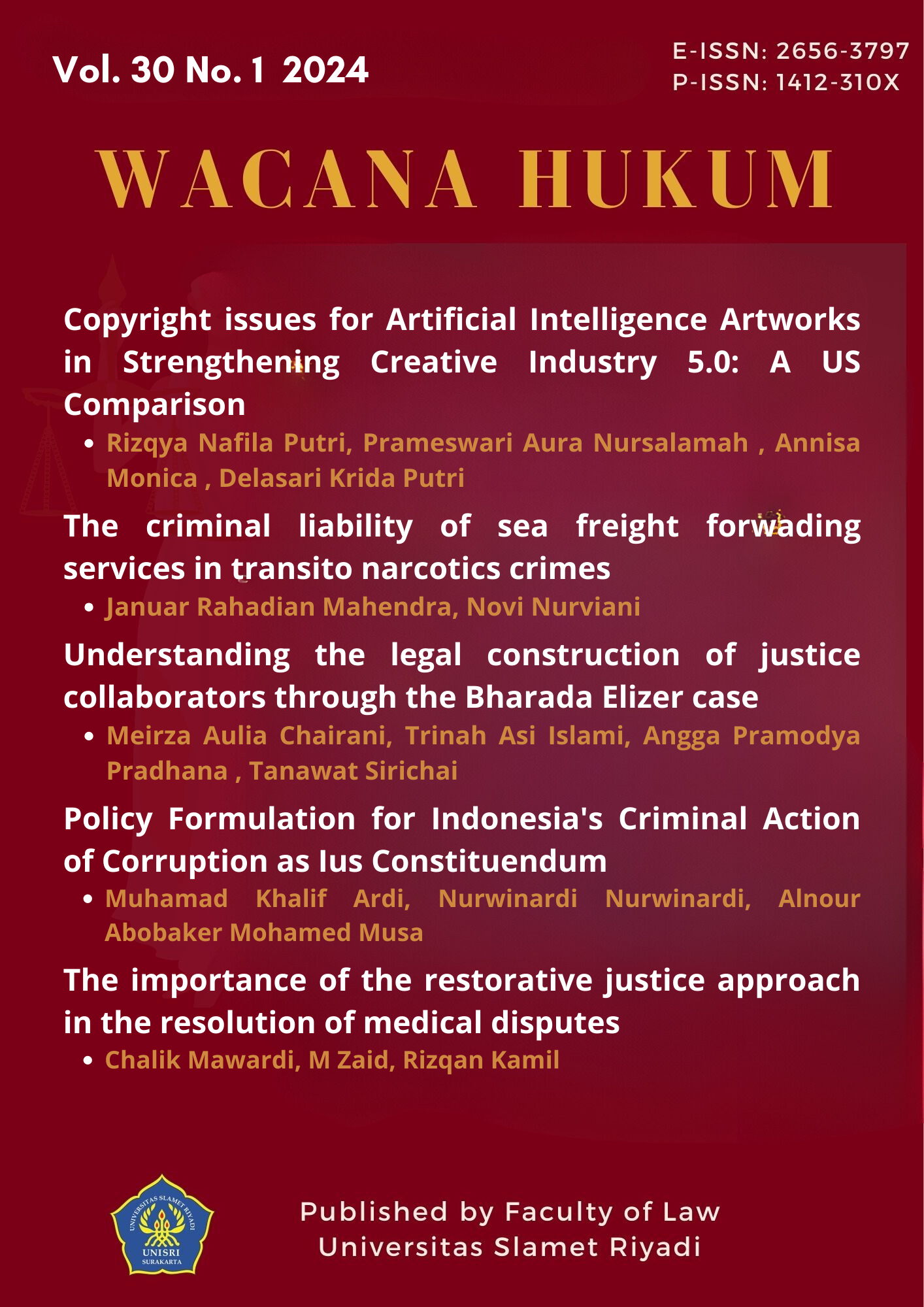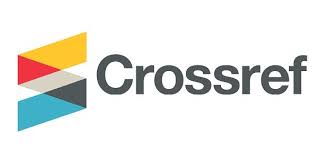Copyright issues for Artificial Intelligence Artworks in Strengthening Creative Industry 5.0: A US Comparison
DOI:
https://doi.org/10.33061/wh.v30i1.10356Keywords:
Artificial Intelligence, Copyright, AI-Created Artwork, Creative Industry Sector, Society 5.0Abstract
AI made human work easier in creating many things, like works of art. However, this is worrying for creators or owners. They are concerned about fulfilling exclusive rights to works of art. AI is part of technological developments that should be used as a tool for creators to create works of art. Therefore, clear boundaries are needed regarding how much AI can be used by creators as a tool in creating works of art so there is no reduction in the value of the creator's own efforts and creativity. The type of research that the author uses is applied descriptive with a qualitative nature. The inductive method is applied to analyze and process data which is linked to existing theories and laws and regulations. The author analyzes the comparison of copyright law protection in Indonesia and in the United States regarding works of art created by AI.
References
Ahanger, Tariq Ahamed, Abdullah Aljumah, and Mohammed Atiquzzaman, ‘State-of-the-Art Survey of Artificial Intelligent Techniques for IoT Security’, Computer Networks, 206 (2022), 108771 <https://doi.org/https://doi.org/10.1016/j.comnet.2022.108771>
Basuki, Agung, M Zaid, Alnour Abobaker, and Mohamed Musa, ‘Establishing Ecological Justice in the Governance of Land Inventory , Ownership , and Utilisation in Indonesia’, Journal of Law, Environmental and Justice, 18.2 (2023), 137–54 <https://doi.org/10.62264/jlej.v1i2.12>
Chimuka, Garikai, ‘Impact of Artificial Intelligence on Patent Law. Towards a New Analytical Framework – [ the Multi-Level Model]’, World Patent Information, 59.October (2019), 101926 <https://doi.org/10.1016/j.wpi.2019.101926>
Clark, Jack, and Ray Perrault, Artificial Intelligence Index Report Introduction to the AI Index Report 2023, Human-Centered Artificial Intelligence, 2023
Davies, Colin R., ‘An Evolutionary Step in Intellectual Property Rights - Artificial Intelligence and Intellectual Property’, Computer Law and Security Review, 27.6 (2011), 601–19 <https://doi.org/10.1016/j.clsr.2011.09.006>
Dudnik, Olesya, Marina Vasiljeva, Nikolay Kuznetsov, Marina Podzorova, Irina Nikolaeva, Larisa Vatutina, and others, ‘Trends, Impacts, and Prospects for Implementing Artificial Intelligence Technologies in the Energy Industry: The Implication of Open Innovation’, Journal of Open Innovation: Technology, Market, and Complexity, 7.2 (2021), 155 <https://doi.org/10.3390/joitmc7020155>
Dwivedi, Yogesh K, Laurie Hughes, Elvira Ismagilova, Gert Aarts, Crispin Coombs, Tom Crick, and others, ‘Artificial Intelligence (AI): Multidisciplinary Perspectives on Emerging Challenges, Opportunities, and Agenda for Research, Practice and Policy’, International Journal of Information Management, 57 (2021), 101994 <https://doi.org/https://doi.org/10.1016/j.ijinfomgt.2019.08.002>
Fujii, Hidemichi, and Shunsuke Managi, ‘Trends and Priority Shifts in Artificial Intelligence Technology Invention: A Global Patent Analysis’, Economic Analysis and Policy, 58.2018 (2018), 60–69 <https://doi.org/10.1016/j.eap.2017.12.006>
Goralski, Margaret A., and Tay Keong Tan, ‘Artificial Intelligence and Sustainable Development’, International Journal of Management Education, 18.1 (2020) <https://doi.org/10.1016/j.ijme.2019.100330>
Guenduez, Ali A., and Tobias Mettler, ‘Strategically Constructed Narratives on Artificial Intelligence: What Stories Are Told in Governmental Artificial Intelligence Policies?’, Government Information Quarterly, 40.1 (2023), 9–10 <https://doi.org/10.1016/j.giq.2022.101719>
Gurkaynak, Gonenc, Ilay Yilmaz, and Gunes Haksever, ‘Stifling Artificial Intelligence: Human Perils’, Computer Law and Security Review, 32.5 (2016), 749–58 <https://doi.org/10.1016/j.clsr.2016.05.003>
Hwang, Gwo-Jen, and Shu-Yun Chien, ‘Definition, Roles, and Potential Research Issues of the Metaverse in Education: An Artificial Intelligence Perspective’, Computers and Education: Artificial Intelligence, 3 (2022), 100082 <https://doi.org/10.1016/j.caeai.2022.100082>
Johnson, Prince Chacko, Christofer Laurell, Mart Ots, and Christian Sandström, ‘Digital Innovation and the Effects of Artificial Intelligence on Firms’ Research and Development – Automation or Augmentation, Exploration or Exploitation?’, Technological Forecasting and Social Change, 179.March (2022), 1 <https://doi.org/10.1016/j.techfore.2022.121636>
Khalif, Muhammad, FX Hastowo Broto Laksito, and Andriamalala Laurent, ‘Role and Position of Indonesian Medical Disciplinary Honour Council : Fair Medical Dispute Resolution’, Journal of Law, Environmental and Justice, 1.3 (2023), 185–201 <https://doi.org/10.62264/jlej.v1i3.15>
van Kolfschooten, Hannah, and Carmel Shachar, ‘The Council of Europe’s AI Convention (2023–2024): Promises and Pitfalls for Health Protection’, Health Policy, 138 (2023), 104935 <https://doi.org/https://doi.org/10.1016/j.healthpol.2023.104935>
Laue, Christian, Virtual Worlds and Criminality, Virtual Worlds and Criminality, 2011 <https://doi.org/10.1007/978-3-642-20823-2>
Mayasari, Hanita, ‘A Examination on Personal Data Protection in Metaverse Technology in Indonesia : A Human Rights Perspective’, Journal of Law, Environmental and Justice, 1.1 (2023), 64–85 <https://doi.org/10.62264/jlej.v1i1.4>
Nave, Eva, and Lottie Lane, ‘Countering Online Hate Speech: How Does Human Rights Due Diligence Impact Terms of Service?’, Computer Law & Security Review, 51 (2023), 105884 <https://doi.org/https://doi.org/10.1016/j.clsr.2023.105884>
Palladino, Nicola, ‘The Role of Epistemic Communities in the “Constitutionalization†of Internet Governance: The Example of the European Commission High-Level Expert Group on Artificial Intelligence’, Telecommunications Policy, 45.6 (2021), 102149 <https://doi.org/https://doi.org/10.1016/j.telpol.2021.102149>
Quintais, João Pedro, Giovanni De Gregorio, and João C Magalhães, ‘How Platforms Govern Users’ Copyright-Protected Content: Exploring the Power of Private Ordering and Its Implications’, Computer Law & Security Review, 48 (2023), 105792 <https://doi.org/https://doi.org/10.1016/j.clsr.2023.105792>
Rammer, Christian, Gastón P. Fernández, and Dirk Czarnitzki, ‘Artificial Intelligence and Industrial Innovation: Evidence from German Firm-Level Data’, Research Policy, 51.7 (2022) <https://doi.org/10.1016/j.respol.2022.104555>
Reisach, Ulrike, ‘The Responsibility of Social Media in Times of Societal and Political Manipulation’, European Journal of Operational Research, 291.3 (2021), 906–17 <https://doi.org/https://doi.org/10.1016/j.ejor.2020.09.020>
Rodrigues, Rowena, ‘Legal and Human Rights Issues of AI: Gaps, Challenges and Vulnerabilities’, Journal of Responsible Technology, 4 (2020), 100005 <https://doi.org/https://doi.org/10.1016/j.jrt.2020.100005>
Saputra, Rian, ‘Development of Creative Industries as Regional Leaders in National Tourism Efforts Based on Geographical Indications’, Bestuur, 8.2 (2020), 108 – 120 <https://doi.org/10.20961/bestuur.v8i2.43139>
Saputra, Rian, Tiara Tiolince, Iswantoro Iswantoro, and Sanju Kumar Sigh, ‘Artificial Intelligence and Intellectual Property Protection in Indonesia and Japan’, Journal of Human Rights, Culture and Legal System, 3.2 (2023), 210–35 <https://doi.org/10.53955/jhcls.v3i2.69>
Saputra, Rian, M Zaid, and Devi Triasari, ‘Executability of the Constitutional Court ’ s Formal Testing Decision : Indonesia ’ s Omnibus Law Review’, Journal of Law, Environmental and Justice, 1.3 (2023), 244–58 <https://doi.org/10.62264/jlej.v1i3.18>
Sari, Onur, and Sener Celik, ‘Legal Evaluation of the Attacks Caused by Artificial Intelligence-Based Lethal Weapon Systems within the Context of Rome Statute’, Computer Law and Security Review, 42 (2021), 105564 <https://doi.org/10.1016/j.clsr.2021.105564>
Sulistianingsih, Dewi, and Apriliana Khomsa Kinanti, ‘Hak Karya Cipta Non-Fungible Token (NFT) Dalam Sudut Pandang Hukum Hak Kekayaan Intelektual’, Krtha Bhayangkara, 16.1 (2022), 197–206 <https://doi.org/10.31599/krtha.v16i1.1077>
Sung, Huang-Chih, ‘Can Online Courts Promote Access to Justice? A Case Study of the Internet Courts in China’, Computer Law & Security Review, 39 (2020), 105461 <https://doi.org/https://doi.org/10.1016/j.clsr.2020.105461>
Syaifudin, M, and S Handayani, ‘Relasi Hukum, Moral Dan Hak Kekayaan Intelektual (Analisis Kontroversi Hukum Dan Moral Rekayasa Genetika Makhluk Hidup Di Indonesia)’, Jurnal Dinamika Hukum, 26.1 (2014), 97–109 <https://doi.org/10.20884/1.jdh.2014.14.1.280>
Tsaih, Rua-Huan, and Chih Chun Hsu, ‘Artificial Intelligence in Smart Tourism: A Conceptual Framework’, 2018
Downloads
Published
How to Cite
Issue
Section
License
Copyright (c) 2024 Rizqya Nafila Putri, Prameswari Aura Nursalamah , Annisa Monica , Delasari Krida Putri

This work is licensed under a Creative Commons Attribution-ShareAlike 4.0 International License.
Authors who publish with this journal agree to the following terms:
- Copyright on any article is retained by the author(s).
- The author grants the journal, the right of first publication with the work simultaneously licensed under a Creative Commons Attribution License that allows others to share the work with an acknowledgment of the work’s authorship and initial publication in this journal.
- Authors are able to enter into separate, additional contractual arrangements for the non-exclusive distribution of the journal’s published version of the work (e.g., post it to an institutional repository or publish it in a book), with an acknowledgment of its initial publication in this journal.
- Authors are permitted and encouraged to post their work online (e.g., in institutional repositories or on their website) prior to and during the submission process, as it can lead to productive exchanges, as well as earlier and greater citation of published work.
- The article and any associated published material is distributed under the Creative Commons Attribution-ShareAlike 4.0 International License

















.png)


